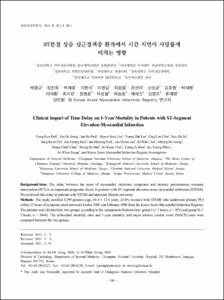KUMEL Repository
1. Journal Papers (연구논문)
1. School of Medicine (의과대학)
Dept. of Internal Medicine (내과학)
ST분절 상승 심근경색증 환자에서 시간 지연이 사망률에 미치는 영향
- Keimyung Author(s)
- Hur, Seung Ho
- Department
- Dept. of Internal Medicine (내과학)
- Journal Title
- 대한내과학회지
- Issued Date
- 2011
- Volume
- 81
- Issue
- 2
- Abstract
- Background/Aims: The delay between the onset of myocardial infarction symptoms and primary percutaneous coronary
intervention (PCI) is an important prognostic factor in patients with ST-segment elevation acute myocardial infarction (STEMI).
We reviewed this delay in patients with STEMI and analyzed clinical outcomes.
Methods: The study enrolled 3,399 patients (age, 61.4 ± 12.8 years; 25.6% women) with STEMI who underwent primary PCI
within 12 hours of symptom onset between October 2005 and February 2008 from the Korea Acute Myocardial Infarction Registry.
The patients were divided into two groups according to the symptom-to-balloon time: group I (≤ 3 hours, n = 955) and group II (>
3 hours, n = 2444). The in-hospital mortality rates and 1-year mortality and major adverse cardiac event (MACE) rates were
compared between the two groups. Results: The mean time interval from the onset of symptoms to arrival at the emergency room (ER) was 188.0 ± 133.6 minutes
(median, 152 minutes). The mean time interval from the ER to reperfusion (door-to-balloon time) was 97.8 ± 67.9 minutes (median,
80 minutes). The mean time interval from the onset of symptoms to reperfusion (symptom-to-balloon time) was 285.8 ± 146.2
minutes (median 250 minutes). The in-hospital mortality rate was significantly lower in group I as compared with group II (3.6%
versus 5.2%, p = 0.044). The 1-year mortality rate was also significantly lower in group I (4.7% versus 7.2%, p = 0.012), while the
1-year MACE rate was not significantly different between groups (17.9% versus 20.4%, p = 0.179).
Conclusions: This study demonstrates that there is a significant pre-hospital time delay in patients with STEMI in Korea and this
time delay is associated with increased 1-year mortality. (Korean J Med 2011;81:199-207)
Keywords: Myocardial infarction; Percutaneous transluminal angioplasty; Time factors
목적: ST분절 상승 심근경색증 환자에서 증상 발생 후 일
차적 관동맥 중재술까지의 시간지연은 중요한 예후인자로
알려져 있다. 본 연구는 ST분절 상승 심근경색증 환자에서
시간지연을 분석하고 증상 발생 후 일차적 관동맥 중재술까
지의 시간이 임상 성적에 미치는 영향을 알아보고자 하였다.
방법: 한국인 급성 심근경색증 등록 연구사업(Korea Acute
Myocardial Infarction Registry, KAMIR)에 등록된 환자 중 증
상 발생 후 12시간 내에 일차적 관동맥 중재술을 시행 받은
ST상승 급성심근경색증 환자 3,399명을 대상으로 하였다.
증상 발생 후 일차적 관동맥 중재술 까지의 시간이 3시간 이
내를 I군(n = 955), 3시간 이상을 II군(n = 2,444)으로 분류하
여 병원 내 사망률, 1년 사망률과 주요 심혈관계 합병증 발
생률을 비교하였다.
결과: 증상 발생 후 병원 도착까지의 평균 시간은 188.0 ±
133.6분(중앙값: 152), 병원 도착 후 일차적 관동맥 중재술
까지의 시간은 평균 97.8 ± 67.9분(중앙값: 80), 증상 발
생 후 일차적 관동맥 중재술까지의 시간은 285.8 ± 146.2분
(중앙값: 250)이었다. 병원 내 사망률은 I군(3.6%)에서 II군
(5.2%, p = 0.044)보다 유의하게 낮았으며, 1년 사망률도 I군
(4.7%)에서 II군(7.2%, p = 0.012)보다 유의하게 낮았다. 1년
주요 심혈관계 합병증 발생률은 양 군 간에 유의한 차이는
없었다(I군 17.9%, II군 20.4%, p = 0.179).
결론: ST분절 상승 심근경색증 환자에서 병원 도착 전 많
은 시간이 지연되며 이러한 시간 지연이 1년 사망률과 연관
성이 있음을 알 수 있었다.
중심 단어: 심근경색; 일차적 관동맥중재술; 시간지연인자
- Alternative Title
- Clinical Impact of Time Delay on 1-Year Mortality in Patients with ST-Segment Elevation Myocardial Infarction
- Keimyung Author(s)(Kor)
- 허승호
- Publisher
- School of Medicine
- Citation
- 박용규 et al. (2011). ST분절 상승 심근경색증 환자에서 시간 지연이 사망률에 미치는 영향. 대한내과학회지, 81(2), 199–207.
- Type
- Article
- ISSN
- 1738-9364
- Appears in Collections:
- 1. School of Medicine (의과대학) > Dept. of Internal Medicine (내과학)
- 파일 목록
-
-
Download
 oak-bbb-00653.pdf
기타 데이터 / 377.41 kB / Adobe PDF
oak-bbb-00653.pdf
기타 데이터 / 377.41 kB / Adobe PDF
-
Items in Repository are protected by copyright, with all rights reserved, unless otherwise indicated.